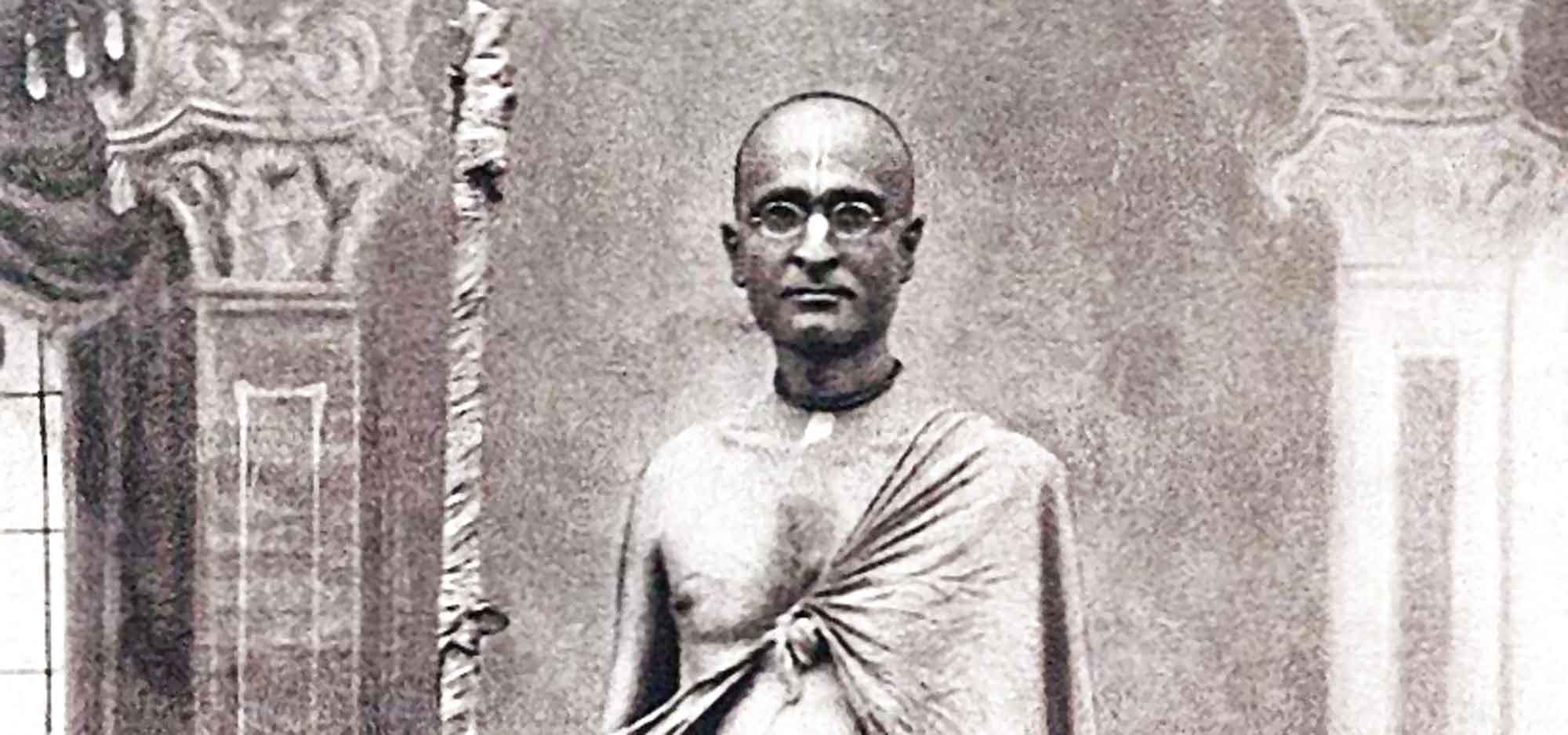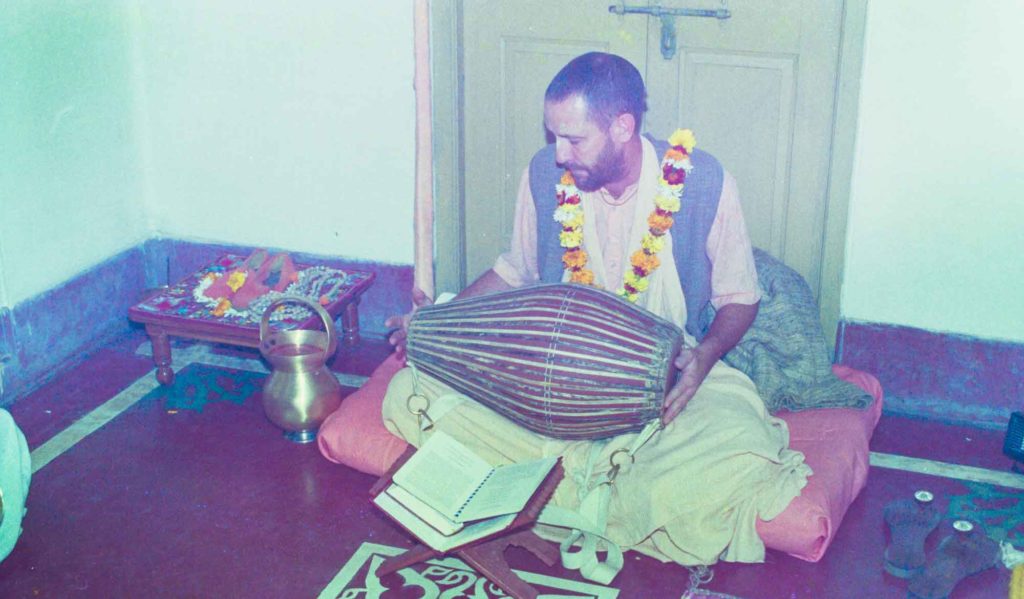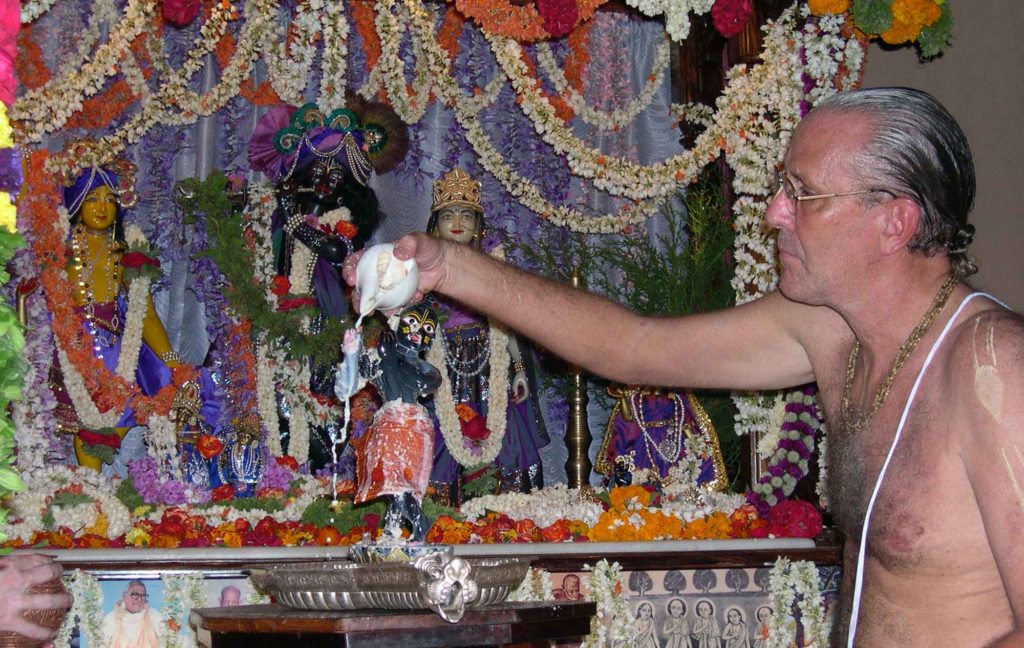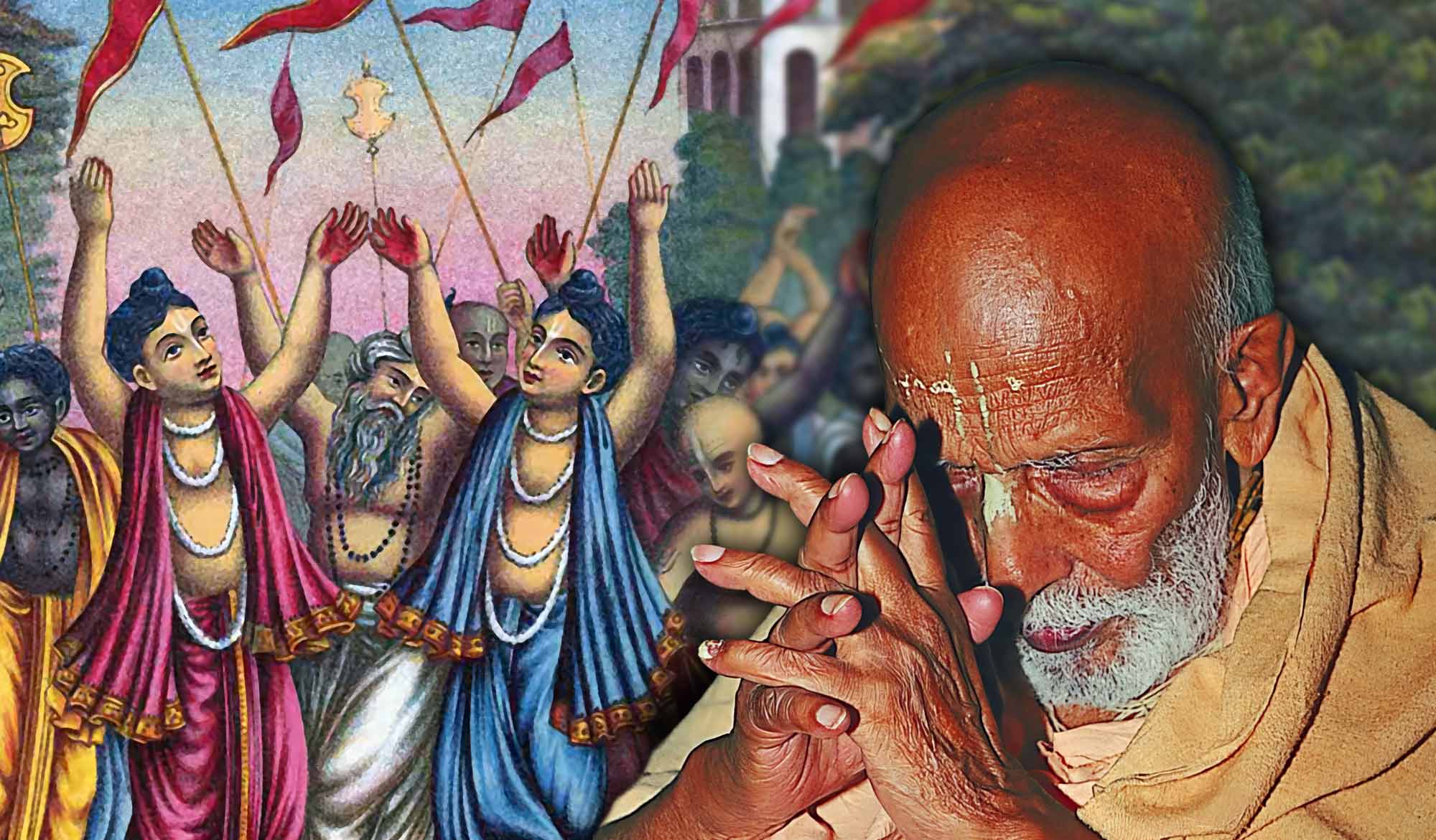Overview
'Why We Fight’ by Swami B.G. Narasingha was first published on October 9th 2006. In this article, Swami Narasingha explains why it is the duty of Gauḍīya Vaiṣṇavas, in particular tridaṇḍi-sannyāsīs, fight against māyā and misconception.
Question: I have noticed that many of your Kṛṣṇa Talk articles have a somewhat controversial spin and even a fighting spirit. Do you think this is actually necessary?
Answer: Yes, preaching means fighting – fighting with illusion and misconception. Our weapons are philosophical arguments backed by śāstra and the opinions of previous ācāryas. Preaching means speaking the truth and the nature of truth is that it wants to be found and it wants to fight with ignorance and misconception.
The māyāvādī thinks that when one has realised the truth, no need of expression is necessary — that one should simply remain silent. But a Vaiṣnava is different. The more a Vaiṣnava realises about the Absolute Truth, the more it is important to speak the truth and to challenge misconception. Bhaktisiddhānta Sarasvatī Ṭhākura has put it this way –
“The effective silencing of the whole race of pseudo-teachers of religion is the first clear indication of the appearance of the Absolute on the mundane plane. The bona-fide teacher of the Absolute, heralds the Advent of Kṛṣṇa by his uncompromising campaign against the pseudo-teachers of religion.” (Excerpted from the essay ‘Pūtanā’ printed in the January 1932 edition of The Harmonist, or Śrī Sajjana Toṣaṇī.)
An ‘uncompromising campaign against the pseudo-teachers of religion’ means to aggressively fight against misconception. Controversy not only sells, but it strengthens one’s conviction also.
siddhānta baliyā citte nā kara alasa
ihā ha-ite kṛṣṇe lāge sudṛḍha mānasa
“One should not neglect to discuss such conclusions, thinking them to be controversial, since such discussions strengthen the mind. In this way one’s mind becomes attached to Kṛṣṇa.” (Caitanya-caritāmṛta, Ādi 2.117)
The truth wants to be found and when it is found it wants to be spread. Like light that comes forth with incredible speed and force to destroy darkness — the truth penetrates the realm of māyā and destroys the ignorance that binds the conditioned souls.
After all, one should remember that Bhagavad-gītā was spoken on the battlefield of Kurukṣetra and not in a bower in Vṛndāvana. Other gītās are spoken by Kṛṣṇa in Vṛndāvana, but only after having destroyed the demons who threatened the peace and well-being of the Vraja-vāsīs.
Unwillingness to confront philosophical controversy stems from a weakness of heart, a lack of faith, a lack of surrender and a lack of attachment to the Supreme Lord. If we love someone and that person is being vilified or misrepresented then our love will command us to defend that person or to oppose their enemies.
We are sometimes unwilling to engage in philosophical controversies, thinking that such a mood is due to anarthas in our own heart or a manifestation of enmity toward other living entities. However, this may be due to apathy rather than humility.
tasmād ajñāna–sambhūtaṁ hṛt-sthaṁ jñānāsinātmanaḥ
chittvainaṁ saṁśayaṁ yogam ātiṣṭhottiṣṭha bhārata
“Therefore the doubts which have arisen in your heart out of ignorance should be slashed by the weapon of knowledge. Armed with yoga, O Bhārata, stand and fight.” (Bhagavad-gītā 4.41)
Here is a summary of the engaging spirit of Śrīla Bhaktisiddhānta and his Gauḍīya Maṭha mission, given by Śrīla Śrīdhara Mahārāja:
“Our Guru Mahārāja was different. Like Mahāprabhu and Nityānanda Prabhu, he wanted to attack maya and, like a great general, he declared totalitarian war on illusion and even all other existing conceptions of religion. ‘Why is there this misunderstanding and misconception?’ he thought. Everything belongs to Kṛṣṇa: īśāvasyam idaṁ sarvam. It is plain and simple and sweet. How can we think, ‘This is for me, that is for Him?’ Why should we let this misconception stand here at all? Attack it and crush the whole thing!
“He told us, ‘Kīrtana means to preach against misconception. As soldiers, you must go door to door and preach Kṛṣṇa consciousness – Kṛṣṇa’s interest – the Kṛṣṇa conception. If they understand that everything is for Kṛṣṇa, they will be saved. This truth is plain and simple. Why should they not understand this? Try to capture them, to release them from the world of misconception and misunderstanding where they are now suffering from reaction.’” (The Golden Volcano of Divine Love, Chapter 3)
“No recognition of the jāti-brāhmaṇas, jāti-gosvāmīs, these bābājīs, the Ramakrishna Mission — all foes, no friend! This is Gauḍīya Maṭha. Single-handed they are fighting with everyone existing in the name of religion or non-religion or hodgepodge religion. Single-handed. Our Guru Mahārāja, on the basis of Bhaktivinoda Ṭhākura’s findings, took the sword and declared war against the whole world. That was his characteristic.” (Encounters With Divinity, page 26-27)
It is easier to recognise the enemy when the enemy says there is no God, God is dead, life comes from matter and so forth, but it becomes more difficult to recognise the enemy when he comes dressed in the guise of a religious mentor (as is the case with the Yavana and Mleccha preachers).
Such so-called religious mentors are sometimes in the dress of the preacher of a foreign religion and sometimes in the dress of a Vaiṣnava. At this time it is certainly more difficult to identify falsity and therefore only the grace of one’s guru and a prudent understanding of Gauḍīya siddhānta will enable us to understand who is who and what is what.
It is not that we should only engage in philosophical controversy with Christians, atheists and māyāvādīs. Anywhere we find the teachings of Mahāprabhu and our ācāryas being minimised or misrepresented, then we must oppose that. It is the duty of a disciple to struggle to uphold the dignity and teachings of his guru and previous ācāryas.
This duty falls particularly to the sannyāsīs who are called, ‘Mahārāja.’ Mahārāja means ‘great king’ and a sannyāsī is called such not because he accumulates great wealth and rules a kingdom (as is the case with many charlatans), but because his duty is to fight against misconception and give support and shelter to the Vaiṣnava community.
Every Gauḍīya Vaiṣnava sannyāsī receives a tridaṇḍa (staff) at the time of initiation and at the top of that tridaṇḍa is a ‘K’ shaped symbol called the paraśu-mudrā meaning the axe. This is not just any axe, but it is a battle-axe to cut the head of illusion and ignorance. Śrīdhara Mahārāja once said, “It is the emblem of cutting the anarthas of those we preach to, as well as those of the disciple.” (Encounters With Divinity, page 180)
If you are interested in joining the fight against maya and engaging yourself wholeheartedly in the service of your Gurudeva without duplicity or weakness of heart. then you should be interested in taking sannyāsa or assisting a sannyāsī in his preaching work. As an anonymous monk once said, “Take sannyāsa or assist the preaching, but whatever you do, don’t give up the fight!”
Related Articles
- 📖 Prabhupāda Vijaya (Book)
- Vairāgya Nāṭaka – A Comedy Drama by Śrīla Prabhupāda
- Guru-Bruva (The Pseudo-Guru) by Śrīla Bhaktisiddhānta Sarasvatī Ṭhākura
- Why We Fight by Śrīla Bhakti Gaurava Narasiṅgha Mahārāja
- Māyāvāda and Buddhism – Are They One and the Same? by Swami B.V. Giri
- Advaita Prakāśa Reviewed
- Prabodhānanda and Prakāśānanda by Swami B.V. Giri
- The Self-Defeating Philosophy of Māyāvāda by Gaura Gopāla Dāsa
- Vaiṣṇavism and Religious Equality by Gaura Gopāla Dāsa
Further Reading
- ‘Tattva Sāra’ (A book by a follower of Ramakrishna) by Śrīla Bhaktivinoda Ṭhākura
- Who is a Māyāvādī? by Śrīla Bhaktivinoda Ṭhākura
- A New Gaurāṅga (Nūtana Gaurāṅga) by Śrīla Bhaktivinoda Ṭhākura
- Siddhānta-Ratna – Written by Śrīyukta Upendra-mohana Gosvāmī of Khaḍadara by Śrīla Bhaktivinoda Ṭhākura
- Samālocana (A Book Review) by Śrīla Bhaktivinoda Ṭhākura
- Impersonal Spirituality and Transcendental Spirituality by Śrīla Bhaktivinoda Ṭhākura
- Samālocanā (A Critique of the book ‘Vanamālā’) by Śrīla Bhaktivinoda Ṭhākura
- Bhakti Caitanya Candrikā by Śrīla Bhaktivinoda Ṭhākura
- The Glory of Ārya Dharma Within Pure Sampradāyas by Śrīla Bhaktivinoda Ṭhākura
- Śrī Dayānanda Sarasvatī and the Tantra Śāstra by Śrīla Bhaktivinoda Ṭhākura
Prabhupāda Śrīla Sarasvatī Ṭhākura’s Visit to Ayodhyā
With the forthcoming observance of Śrī Rāma Navamī, we present 'Prabhupāda Śrīla Sarasvatī Ṭhākura’s Visit to Ayodhyā' written by Śrīla Bhaktisiddhānta Sarasvatī Ṭhākura Prabhupāda from The Gaudīyā magazine, Vol 3. Issue 21/ In December 1924, after visiting Benares and Prāyāga, Sarasvatī Ṭhākura visited the birth-site of Śrī Rāmācandra in Ayodhyā.
Śaraṇāgati – The Only Path to Auspiciousness
In this article, 'Śaraṇāgati - The Only Path to Auspiciousness', Dhīra Lalitā Dāsī analyses the process of śaraṇāgati (surrender) beginning with śraddhā (faith). She also discusses the role of śāstra and the Vaiṣṇava in connection with surrender.
Ātma Samīkṣā – The Value of Introspection
In this article, "Ātma Samīkṣā – The Value of Introspection" Kalki Dāsa highlights the importance of introspection in the life of a devotee and especially in relation to the worldly environment that surrounds us. He also explains how transcendental sound influences our capacity to introspect.
Svasti No Gaura-vidhur Dadhātu (May the Moon-like Gaura Bestow Auspiciousness)
This Bengali poem, ‘Svasti No Gaura-vidhur Dadhātu,’ (May the Moon-like Gaura Bestow Auspiciousness) written by Śrīla Bhakti Pramoda Purī Gosvāmī, was first published in 1965 in Caitanya Vāṇī magazine, Vol.5, Issue 1. In this composition, Śrīla Purī Mahārāja gives advice to the fallen jīvas to sincerely accept Mahāprabhu's gift of the Holy Name. This poem was translated into English by Sanātana Dāsa and Parameśvarī Devī Dāsī.
Prabhupāda Śrīla Sarasvatī Ṭhākura’s Visit to Ayodhyā
With the forthcoming observance of Śrī Rāma Navamī, we present 'Prabhupāda Śrīla Sarasvatī Ṭhākura’s Visit to Ayodhyā' written by Śrīla Bhaktisiddhānta Sarasvatī Ṭhākura Prabhupāda from The Gaudīyā magazine, Vol 3. Issue 21/ In December 1924, after visiting Benares and Prāyāga, Sarasvatī Ṭhākura visited the birth-site of Śrī Rāmācandra in Ayodhyā.
Śaraṇāgati – The Only Path to Auspiciousness
In this article, 'Śaraṇāgati - The Only Path to Auspiciousness', Dhīra Lalitā Dāsī analyses the process of śaraṇāgati (surrender) beginning with śraddhā (faith). She also discusses the role of śāstra and the Vaiṣṇava in connection with surrender.
Ātma Samīkṣā – The Value of Introspection
In this article, "Ātma Samīkṣā – The Value of Introspection" Kalki Dāsa highlights the importance of introspection in the life of a devotee and especially in relation to the worldly environment that surrounds us. He also explains how transcendental sound influences our capacity to introspect.
Svasti No Gaura-vidhur Dadhātu (May the Moon-like Gaura Bestow Auspiciousness)
This Bengali poem, ‘Svasti No Gaura-vidhur Dadhātu,’ (May the Moon-like Gaura Bestow Auspiciousness) written by Śrīla Bhakti Pramoda Purī Gosvāmī, was first published in 1965 in Caitanya Vāṇī magazine, Vol.5, Issue 1. In this composition, Śrīla Purī Mahārāja gives advice to the fallen jīvas to sincerely accept Mahāprabhu's gift of the Holy Name. This poem was translated into English by Sanātana Dāsa and Parameśvarī Devī Dāsī.








